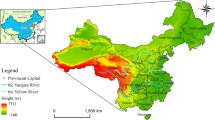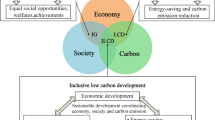Abstract
From a spatial perspective, this paper constructs a spatial Durbin model based on the adjacent weight matrix to analyze the impact of environmental regulation on the development of renewable energy in 30 provinces (autonomous regions and municipalities directly under the Central Government) in China from 2007 to 2020. The results show that (1) both environmental regulation and renewable energy development have positive spatial autocorrelation and form relatively similar spatial agglomeration areas, specifically showing the characteristics of “high-high” agglomeration in resource-rich areas and “low-low” agglomeration in resource-scarce areas. (2) Environmental regulation significantly promotes the development of local renewable energy and has a significant spatial spillover effect on the development of renewable energy in neighboring provinces. (3) The moderating effect results show that renewable energy installed capacity and electricity demand play an inverse moderating role between environmental regulation and renewable energy development. (4) From the perspective of different regions, the impact of environmental regulation on the development of renewable energy is heterogeneous. Based on the research conclusions, this paper finally provides corresponding policy suggestions from three aspects: regional cooperation, technical support, and differentiation.




Similar content being viewed by others
Data availability
The datasets used and/or analyzed during the current study are available from the corresponding author on reasonable request.
References
Abbas S, Gui P, Chen AI, Ali N (2022) The effect of renewable energy development, market regulation, and environmental innovation on CO2 emissions in BRICS countries. Environ Sci Pollut Res 29:59483–59501. https://doi.org/10.1007/s11356-022-20013-7
Adedoyin FF, Bekun FV, Alola AA (2020) Growth impact of transition from non-renewable to renewable energy in the EU: the role of research and development expenditure. Renew Energy 159:1139–1145. https://doi.org/10.1016/j.renene.2020.06.015
Akintande OJ, Olubusoye OE, Adenikinju AF, Olanrewaju BT (2020) Modeling the determinants of renewable energy consumption: evidence from the five most populous nations in Africa. Energy 206:12. https://doi.org/10.1016/j.energy.2020.117992
Ambec S, Cohen MA, Elgie S, Lanoie P (2013) The Porter hypothesis at 20: can environmental regulation enhance innovation and competitiveness? Rev Environ Econ Policy 7(1):2–22. https://doi.org/10.1093/reep/res016
Andor M, Voss A (2016) Optimal renewable-energy promotion: capacity subsidies vs. generation subsidies. Resour Energy Econ 45:144–158. https://doi.org/10.1016/j.reseneeco.2016.06.002
Ankrah I, Lin BQ (2020) Renewable energy development in Ghana: beyond potentials and commitment. Energy 198:13. https://doi.org/10.1016/j.energy.2020.117356
Anton SG, Nucu AEA (2020) The effect of financial development on renewable energy consumption. A panel data approach. Renew Energy 147:330–338. https://doi.org/10.1016/j.renene.2019.09.005
Apergis N, Payne JE (2014) The causal dynamics between renewable energy, real GDP, emissions and oil prices: evidence from OECD countries. Appl Econ 46(36):4519–4525. https://doi.org/10.1080/00036846.2014.964834
Chege SM, Wang D (2020) The influence of technology innovation on SME performance through environmental sustainability practices in Kenya. Technol Soc 60:101210. https://doi.org/10.1016/j.techsoc.2019.101210
Chodkowska-Miszczuk J, Bieganska J, Sroda-Murawska S, Grzelak-Kostulska E, Rogatka K (2016) European Union funds in the development of renewable energy sources in Poland in the context of the cohesion policy. Energy Environ 27(6–7):713–725. https://doi.org/10.1177/0958305x16666963
Ding H, Zhou D, Zhou P (2020) Optimal policy supports for renewable energy technology development: a dynamic programming model. Energy Econ 92:104765. https://doi.org/10.1016/j.eneco.2020.104765
Drori I, Honig B (2013) A process model of internal and external legitimacy. Organ Stud 34(3):345–376. https://doi.org/10.1177/0170840612467153
Elavarasan RM, Shafiullah GM, Padmanaban S et al (2020) A comprehensive review on renewable energy development, challenges, and policies of leading Indian states with an international perspective. IEEE Access 8:74432–74457. https://doi.org/10.1109/ACCESS.2020.2988011
Eren BM, Taspinar N, Gokmenoglu KK (2019) The impact of financial development and economic growth on renewable energy consumption: empirical analysis of India. Sci Total Environ 663:189–197. https://doi.org/10.1016/j.scitotenv.2019.01.323
Fang XM, Wang L, Sun CW, Zheng XM, Wei J (2021) Gap between words and actions: empirical study on consistency of residents supporting renewable energy development in China. Energy Policy 148:10. https://doi.org/10.1016/j.enpol.2020.111945
González P, Sarkis J, Adenso-Díaz B (2008) Environmental management system certification and its influence on corporate practices: evidence from the automotive industry. Int J Oper Prod Manag 28(11):1021–1041. https://doi.org/10.1108/01443570810910179
Grzeszczyk TA, Izdebski W, Izdebski M, Wascinski T (2021) Socio-economic factors influencing the development of renewable energy production sector in Poland. E & M Ekonomie a Management 24(1):38–54. https://doi.org/10.15240/tul/001/2021-1-003
He YX, Xu Y, Pang YX, Tian HY, Wu R (2016) A regulatory policy to promote renewable energy consumption in China: review and future evolutionary path. Renew Energy 89:695–705. https://doi.org/10.1016/j.renene.2015.12.047
Ji Q, Zhang DY (2019) How much does financial development contribute to renewable energy growth and upgrading of energy structure in China? Energy Policy 128:114–124. https://doi.org/10.1016/j.enpol.2018.12.047
Johnstone N, Hascic I, Popp D (2010) Renewable energy policies and technological innovation: evidence based on patent counts. Environ Resour Econ 45(1):133–155. https://doi.org/10.1007/s10640-009-9309-1
Keyuraphan S, Thanarak P, Ketjoy N, Rakwichian W (2012) Subsidy schemes of renewable energy policy for electricity generation in Thailand. Paper presented at the 3rd International Science, Social Science, Engineering and Energy Conference (ISEEC), Nakhon Pathom, Thailand
Li D, Tang F, Jiang J (2019) Does environmental management system foster corporate green innovation? The moderating effect of environmental regulation. Tech Anal Strat Manag 31(10):1242–1256. https://doi.org/10.1080/09537325.2019.1602259
Liu JX (2019) China’s renewable energy law and policy: a critical review. Renew Sustain Energy Rev 99:212–219. https://doi.org/10.1016/j.rser.2018.10.007
Lo K (2014) A critical review of China’s rapidly developing renewable energy and energy efficiency policies. Renew Sustain Energy Rev 29:508–516. https://doi.org/10.1016/j.rser.2013.09.006
Meng F, Xu Y, Zhao G (2020) Environmental regulations, green innovation and intelligent upgrading of manufacturing enterprises: evidence from China. Sci Rep 10(1):1–17. https://doi.org/10.1038/s41598-020-71423-x
Moon S, Bae S, Jeong MG (2014) Corporate sustainability and economic performance: an empirical analysis of a voluntary environmental program in the USA. Bus Strateg Environ 23(8):534–546. https://doi.org/10.1002/bse.1800
Oslaj M, Mursec B (2010) Biogas as a renewable energy source. Tehnicki Vjesnik-Technical Gazette, 17(1), 109–114. Retrieved from <Go to ISI>://WOS:000276710700014
Ramanathan R, He Q, Black A et al (2017) Environmental regulations, innovation and firm performance: a revisit of the Porter hypothesis. J Clean Prod 155:79–92. https://doi.org/10.1016/j.jclepro.2016.08.116
Roberta A, Oriana R, Luisa D (2017) The role of fiscal incentives for renewable energy on economic growth. Int J Bus Soc Sci 18(2): 387–396. Retrieved from <Go to ISI>://WOS:000416089800012
Sadorsky P (2009) Renewable energy consumption, CO(2) emissions and oil prices in the G7 countries. Energy Econ 31(3):456–462. https://doi.org/10.1016/j.eneco.2008.12.010
Saidi K, Omri A (2020) The impact of renewable energy on carbon emissions and economic growth in 15 major renewable energy-consuming countries. Environ Res 186:11. https://doi.org/10.1016/j.envres.2020.109567
Saint Akadiri S, Alola AA, Akadiri AC, Alola UV (2019) Renewable energy consumption in EU-28 countries: policy toward pollution mitigation and economic sustainability. Energy Policy 132:803–810. https://doi.org/10.1016/j.enpol.2019.06.040
Sun H, Liu Z, Chen Y (2020) Foreign direct investment and manufacturing pollution emissions: a perspective from heterogeneous environmental regulation. Sustain Dev 28(5):1376–1387. https://doi.org/10.1002/sd.2091
Wagner M (2007) On the relationship between environmental management, environmental innovation and patenting: evidence from German manufacturing firms. Res Policy 36(10):1587–1602. https://doi.org/10.1016/j.respol.2007.08.004
Xia TS, Ji Q, Zhang DY, Han JH (2019) Asymmetric and extreme influence of energy price changes on renewable energy stock performance. J Clean Prod 241:10. https://doi.org/10.1016/j.jclepro.2019.118338
Xu XF, Wei ZF, Ji Q, Wang CL, Gao GW (2019) Global renewable energy development: influencing factors, trend predictions and countermeasures. Resour Policy 63:15. https://doi.org/10.1016/j.resourpol.2019.101470
Yang DX, Chen ZY, Nie PY (2016a) Output subsidy of renewable energy power industry under asymmetric information. Energy 117:291–299. https://doi.org/10.1016/j.energy.2016.10.089
Yang J, Zhang W, Zhang ZY (2016b) Impacts of urbanization on renewable energy consumption in China. J Clean Prod 114:443–451. https://doi.org/10.1016/j.jclepro.2015.07.158
Yang DX, Chen ZY, Yang YC, Nie PY (2019a) Green financial policies and capital flows. Physica A: Statistical Mechanics and Its Applications 522:135–146. https://doi.org/10.1016/j.physa.2019.01.126
Yang F, Cheng YY, Yao X (2019b) Influencing factors of energy technical innovation in China: evidence from fossil energy and renewable energy. J Clean Prod 232:57–66. https://doi.org/10.1016/j.jclepro.2019.05.270
Yang DX, Jing YQ, Wang C, Nie PY, Sun P (2021) Analysis of renewable energy subsidy in China under uncertainty: feed-in tariff vs. renewable portfolio standard. Energ Strat Rev 34:11. https://doi.org/10.1016/j.esr.2021.100628
Zeppini P, van den Bergh J (2020) Global competition dynamics of fossil fuels and renewable energy under climate policies and peak oil: a behavioural model. Energy Policy 136:24. https://doi.org/10.1016/j.enpol.2019.110907
Funding
This work is partially supported by the Natural Science Foundation of Hunan Province (2020JJ5111) and Youth Innovation Driven Project of Hunan University of Technology and Business (19QD04). This work is supported by the National Social Science Fund of China (21FJYB012), China Postdoctoral Science Foundation (2021M690971), Scientific Research Project of Hunan Education Department (21B0576), Project of Hunan Social Science Achievement Appraisal Committee (XSP20YBZ081), and Graduate Research and Innovation Project of Hunan Province (CX20221146).
Author information
Authors and Affiliations
Contributions
All authors contributed to the study conception and design. Material preparation, data collection, and analysis were performed by DXY, AYT, and ZYL. The first draft of the manuscript was written by LT, and the translation was written by QGW. All authors commented on previous versions of the manuscript. All authors read and approved the final manuscript.
Corresponding author
Ethics declarations
Ethical approval
Not applicable.
Consent to participate
Not applicable.
Consent for publication
The authors agree to publish in the journal.
Competing interests
The authors declare no competing interests.
Additional information
Responsible Editor: Roula Inglesi-Lotz
Publisher's note
Springer Nature remains neutral with regard to jurisdictional claims in published maps and institutional affiliations.
Rights and permissions
Springer Nature or its licensor (e.g. a society or other partner) holds exclusive rights to this article under a publishing agreement with the author(s) or other rightsholder(s); author self-archiving of the accepted manuscript version of this article is solely governed by the terms of such publishing agreement and applicable law.
About this article
Cite this article
Yang, D., Tan, L., Wu, Q. et al. The impact of environmental regulation on renewable energy development in China from the perspective of spatial effects. Environ Sci Pollut Res 31, 10234–10249 (2024). https://doi.org/10.1007/s11356-023-30237-w
Received:
Accepted:
Published:
Issue Date:
DOI: https://doi.org/10.1007/s11356-023-30237-w




